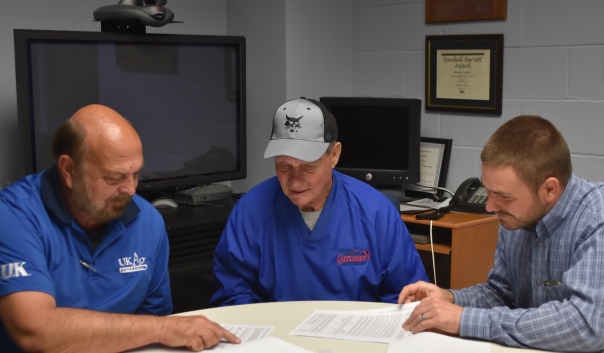Always improving
(First appeared in Kentucky Cattlemen’s Association publication Cow Country News June issue)
Ed Note: This is the first in a series of articles that will be covering those selling beef in Kentucky. We will focus on producers across the state who are all making an impact in their own way. Stories will include individuals selling freezer beef,those selling further processed beef and those selling beef products direct into the retail and food service areas, to name a few. It also includes stories like this one on producers who are making decisions on the farm that affect the end product. All of these people are making an impact on our industry and we want to focus on their success and struggles.
Enjoy
By Ray Bowman
Some Kentucky beef producers are shipping their steers to Iowa. What’s coming back is verified, valuable statistical information that could help them improve the makeup of their herd and have a very positive impact on cattle production in the Commonwealth.
The Tri-County Steer Carcass Futurity program has been in place for over 30 years, started by Pottawattamie, Cass and Shelby County Cattleman’s Associations in 1982.
The goal of the program is to provide information to beef producers they can use in managing and marketing their product. It provides cow-calf producers information on feedlot performance, average daily gain and carcass data on one or more steers/heifers entered.
The 10-member board that oversees the Futurity is made up of representatives from various segments of the beef industry. Their aim is to identify problems facing cow-calf producers and evaluate alternatives that can be demonstrated and shared with fellow consignors.
Producers sending their stock to the program retain ownership of the animals and receive compensation for the animals. When the cattle are harvested, the owners get the sale price of the carcass, minus feed and maintenance costs.

Doug Shepherd, KCA president Chuck Crutcher and Hardin County Extension agent Matt Adams look over some numbers from the Tri-County Steer Carcass Futurity
“We started back in 2005 when we shipped the first two loads out there,” recalls Doug Shepherd, Hardin County extension agent, who, along with current Kentucky Cattleman’s Association president Chuck Crutcher of Rineyville, was instrumental in starting the project. Shepherd says it was a leap of faith to ship two semi-loads of calves to Iowa, even though little was actually known about the Futurity.
“Chuck and I hopped on a plane and landed out there four hours after the cattle arrived,” Shepherd continues. “We were totally impressed with what we saw and we came back and told the consignors they needed to go out and see this for themselves.”
Annual field trips continue to be a feature of Kentucky’s involvement with the program.
Since that initial venture, Shepherd says there has been a consistent flow of cattle from a number of Kentucky counties out to the feed lots designated by the Tri-County board. Kentucky is one of some sixteen states and one Canadian province that have sent stock to the futurity.
Cattle entered into the program must meet the Commonwealth’s CPH-45 requirements.
Currently, the cattle are loaded out at a number of sites, primarily stockyards. Shepherd says he hopes a dedicated livestock management facility will be built near Elizabethtown in the coming year.
After the steers have spent their time in the feed yard and are harvested, the information starts to flow back to the Kentucky consignors. “It’s a whole lot of data,” Shepherd observes.
When the numbers are in, the producers come to the Hardin County Extension offices to hear economists, meat scientists and animal nutritionists help them make sense – and practical application – of it all in order to improve the quality of their herds and the strength of their bottom line.
“They sit down with these guys and go over the numbers, column by column, how their cattle performed, what they need to consider changing in their operation,” Shepherd explains. “When we started this thing, we were averaging 35 to 37 percent choice grades, way below the national average. We’re up to a point where we have some loads hitting 90 percent choice.”
“What the consumer is demanding now, they want to know how cattle are treated, how cattle are fed, they’re very conscious of that,” Chuck Crutcher noted. “If we can put a better product on the table, that’s what we all should be doing.”
Posted on June 7, 2017, in Uncategorized. Bookmark the permalink. 1 Comment.


Pingback: Always improving | Morning Ag Clips